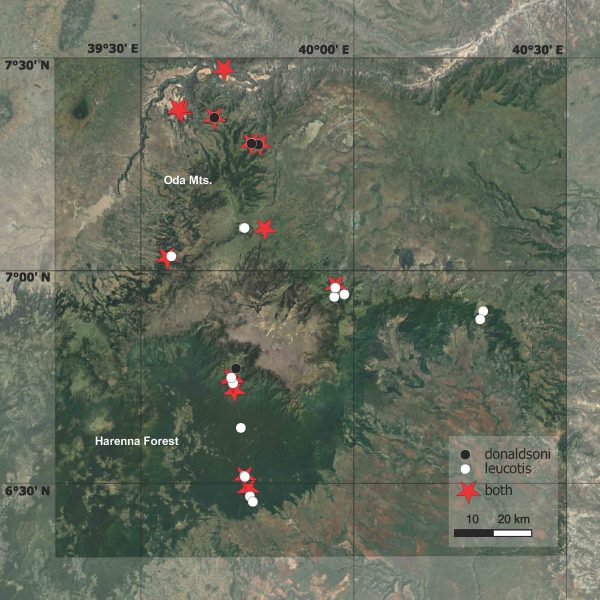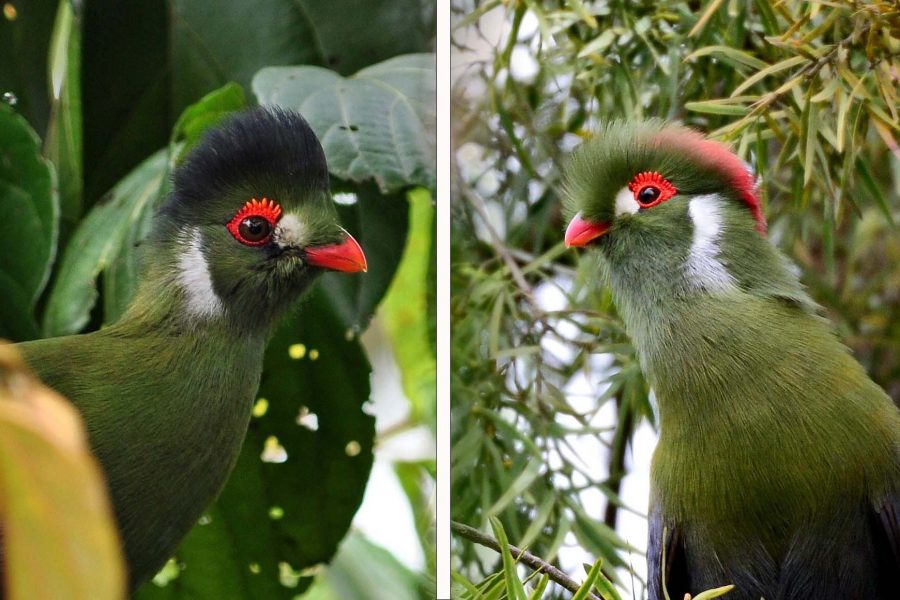Originally, three turaco species were described from the Horn of Africa: the widespread White-cheeked Turaco Tauraco leucotis, the Crimson-crested Turaco T. donaldsoni, and the Ruspoli’s Turaco T. ruspolii, the latter two being endemic Ethiopian taxa. Subsequent taxonomic revisions relegated the Crimson-crested Turaco to a subspecies of the White-cheeked Turaco, and this classification is now of long standing. This revision was the result of an ambiguous interpretation of their actual ranges due to a lack of reliable information on their potential geographical overlap, and was generally accepted until a recent molecular genetic study. This study proposed that all three Ethiopian turacos be treated at species level and be assigned to the distinct genus Menelikornis, while still assuming parapatry between the White-cheeked and Crimson-crested Turaco. This prompted us to undertake a focused field study to collect new records to complement our previous observational data from the zone of overlap.

Figure 1. The three Menelikornis turaco species from the Horn of Africa (from left to right): White-cheeked Turaco M. leucotis – Crimson-crested Turaco M. donaldsoni – Ruspoli’s Turaco M. ruspolii. (Photos: T. Pröhl – K. Gedeon – T. Pröhl).
Adding new field records from the zone of geographical overlap
In 2019 and 2021, we collected nearly 40 records of the two turaco taxa, White-cheeked and Crimson-crested. The study area stretched 120 km north to south from the upper Shabelle Valley via the Oda and Bale Mts. to Harenna Forest. It harboured both White-cheeked and Crimson-crested Turacos, resulting in an area of range overlap of at least about 6,000 km², confirming their sympatry. Within the region of overlap, the relative frequency of the two taxa varies. We always encountered White-cheeked and Crimson-crested Turacos separately, never in mixed flocks, and are only aware of a single observation of a mixed group, from around 2007. We also found no evidence of elevational segregation between the two taxa and there was no evidence of hybridization, although hybrids between White-cheeked and Ruspoli’s Turacos have been identified repeatedly.

Figure 2. Records of White-cheeked Turaco (white dots) and Crimson-crested Turaco (black dots) from the zone of overlap in Ethiopia, plus interview data on the sympatric occurrence of both taxa (red stars). (Map data: Google Image Landsat / Copernicus)
A note on morphology and identification
It has been suggested that reproductive isolation between sympatric turaco species is mainly due to ecological barriers, because their social behaviours are similar, and they easily hybridise in captivity. However, there are reports of aggressive behaviour between the species where they meet in the wild, and plumage colour differences may play an important role in this context. Displaying otherwise concealed plumage features apparently plays an important role in turacos, both in threat gestures and courtship. Indeed, the colour of the erect crest of the Crimson-crested Turaco is very conspicuous and differs significantly from the dark blue of the White-cheeked Turaco. When the crest is relaxed, this difference is much less conspicuous and therefore often under-estimated as a useful identification character in handbooks and field guides.

Figure 3. Portraits of White-cheeked Turaco (left) and Crimson-crested Turaco (right). Note the pronounced colour difference of the erect crest that much less conspicuous when relaxed. (Photos: V. Sthamer)
So, what can we learn from the combined evidence?
The sympatry of the White-cheeked and Crimson-crested Turacos, together with clear differences in morphology (mainly crest colour), as well as molecular evidence, strongly support treating the two as different species. In which case, there is indeed another endemic bird species to be added to Ethiopia’s bird list: the Crimson-crested Turaco Menelikornis donaldsoni.
A challenge for conservation
The Crimson-crested Turaco is endemic to a comparatively small montane area in north-east Ethiopia where forests have now largely disappeared, except for a few larger remnants and some widely scattered forest ‘islands’. Forest devastation continues in parts of the range of the Crimson-crested Turaco, as we witnessed in 2019 and 2021 in the Oda Mts., in the northern Bale Massif. There is little information on the distribution and abundance of the Crimson-crested Turaco where it persists, so that at present no reliable statements can be made concerning its IUCN threat status. However, non-timber crops, logging, plantations, and livestock farming have been listed among the threats to Ruspoli’s Turaco, which is currently classified as Near Threatened, and the same threats are likely to affect the Crimson-crested Turaco as well.

Figure 4. Habitat of the Crimson-crested Turaco in the Oda Mts., northern Bale Massif. The occurrence of the birds is restricted to such montane forest remnants. (Photo: T. Töpfer)
What next?
Because vocalisations are an important element of species recognition, it may be worthwhile to explore possible differences in the calls of the two taxa, when high-quality recordings from the contact zone become available. Because different turaco populations from different areas of Ethiopia are reported to differ in plumage colour characteristics to some degree, further research is needed to determine if these differences (including UV signatures) are consistent. Additionally, studies on habitat differences between White-cheeked and Crimson-crested Turaco would be of value. Finally, the role of other potential reproductive barriers, such as plumage colour and behaviour, should be studied to provide additional explanations for their specific segregation.
References
Ash, J. S. & Atkins, J. 2009. Birds of Ethiopia and Eritrea: an atlas of distribution. Christopher Helm, London.
del Hoyo, J. & Collar, N. J. 2014. HBW and BirdLife International illustrated checklist of the birds of the world, vol. 1. Lynx Edicions, Barcelona.
Perktaş, U., Groth, J. G. & Barrowclough, G. F. 2020. Phylogeography, species limits, phylogeny, and classification of the turacos (Aves: Musophagidae) based on mitochondrial and nuclear DNA sequences. Am. Mus. Novit. 3934: 1‒61.
Author information:
Leibniz Institute for the Analysis of Biodiversity Change, Museum Koenig Bonn, Sektion Ornithologie, Adenauerallee 160, 53113 Bonn, Germany. E-mail: k.gedeon@gmail.com; T.Toepfer@leibniz-zfmk.de
